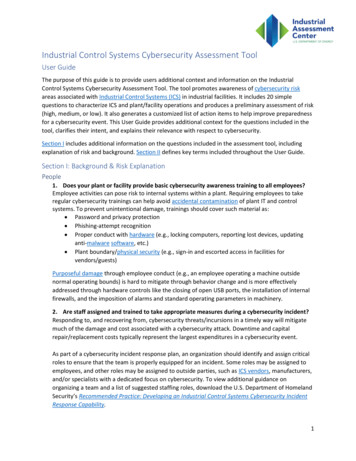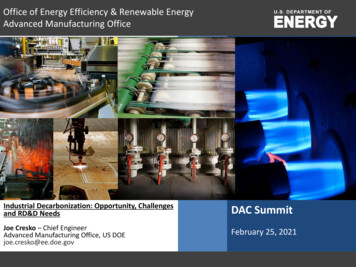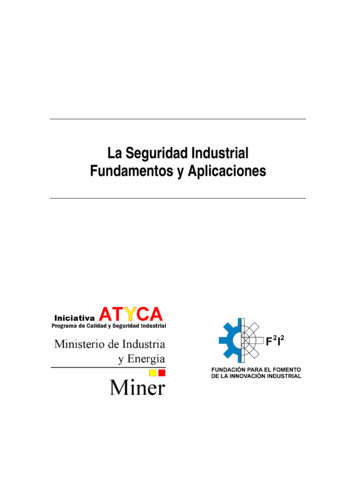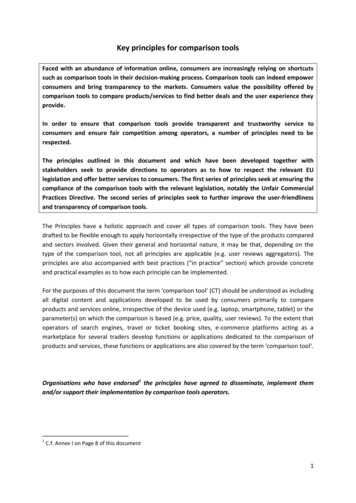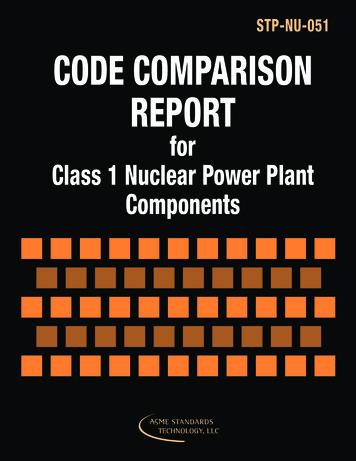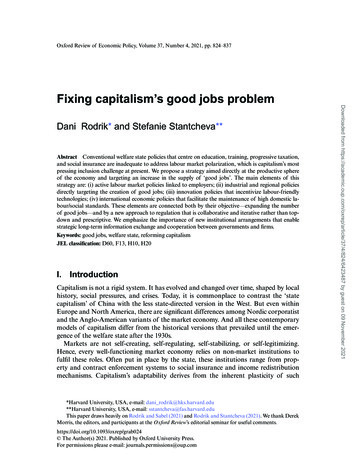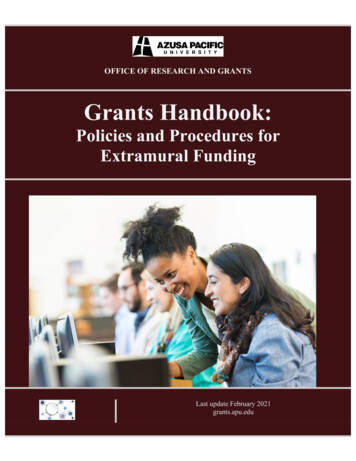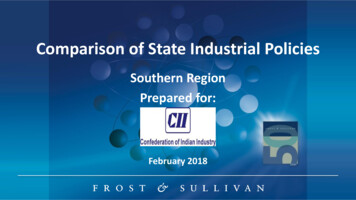
Transcription
Comparison of State Industrial PoliciesSouthern RegionPrepared for:February 2018
Executive Summary2
India ScenarioIndia is one of the fastest growing nations in the world, which boasts of 7% to 7.5% GDP growth per year and awhopping millennial population of 600 million.With the advent of technology and related disruptions, India is catching up with its global counterparts in terms ofinnovation and pioneering business models and strategies.Alongside, the huge and diverse consumer market and growing income levels are poised to provide the necessaryboost to innovators to profitably tap market opportunities and sustain competition. Active support from the presentGovernment toward removing several regulatory and infrastructural roadblocks should bolster the investmentscenario in India.In the last 3-4 years, Government of India has initiated numerous measures to boost doing business in India byimproving and streamlining the business climate. The World Bank Doing Business Report 2017 portrays India asrank 130th, a major improvement of 12 positions from 142nd rank in 2015. The Government now envisions India tobe positioned among the top 50 countries in the coming years.In order to achieve this status, the States need to engage in impending structural reforms. To begin with, theDepartment of Industrial Policy & Promotion (DIPP) introduced ranking of the states on Ease of Doing Business in2015, which was done on 98 parameters. In 2016, the same practice was repeated and the assessment of statesbecame more in-depth and they were assessed on total 336 parameters.3
India Scenario – continuedThis rigorous reform process has been broadly based on 10 parameters, namely: Single window clearanceLabour regulation enablersOnline tax return filingInspection reform enablersCommercial dispute resolution enablersAvailability of landConstruction permit enablersAccess to information and transparency enablersObtaining electricity connectionEnvironment registration enablersIn the recent assessment of 2016, the final result exhibits that the states have progressively developed tomake it easier to do business. This is substantiated by the fact that the current national implementationaverage is 48.9%; this is significantly higher than the 2015 national average of 32%.4
Focus on the Southern part of India : Andhra Pradesh, Karnataka,Kerala, Puducherry, Tamil Nadu and TelanganaThe state governments,particularly of the SouthernRegion, have consistentlyincorporated an acquiescentpolicy ambience that developsprivate enterprise, nurturesMSMEs, and makes investingin the state beneficial, whichin turn will alleviate povertyand curtail unemployment.Progressive industrial §or specific policies areenabling the states toshowcase a bullishinvestment scenario.Encompassing the individualstates’ USPs and key growthsectors, the stategovernments have constitutedsector-specific policies topromote investments, coupledwith general package offinancial incentives.The Southern regional statesare trying their level best tooffer different best-in-classpolicy instruments and fiscalimpetus with the sole target toboost industrial growth.5
Overview of the Specified Southern StatesAndhra Pradesh - Andhra Pradesh (AP) has a 974 km of coastline and is located in theSouthern peninsula of India. Andhra Pradesh is surrounded by Chhattisgarh (North), Odisha(Northeast), Telangana and Karnataka (West), Tamil Nadu (South), and the Bay of Bengal(East). As of July 2016, the state had 19 operational SEZs covering diversified sectorsincluding textiles and apparel, food processing, footwear and leather products, multi-product,pharma, IT SEZs and so on.Karnataka - Karnataka is situated in the southern part of India. It is enclosed by theArabian Sea on the west, Goa on the northwest, Maharashtra on the north, AndhraPradesh on the east, Tamil Nadu on the southeast, and Kerala on the southwest.Karnataka is known as the IT hub of India and has the fourth largest technology cluster inthe world. There are 47 IT/ITeS SEZs, three software technology parks, and dedicated ITinvestment regions in Karnataka.Kerala - Kerala also known as God's own country is located along the coastline on thesouthwest of the Indian peninsula, bordered by the Arabian Sea on the west and the WesternGhats on the east. Kerala has a widely diversified fiscal and policy incentives for businessesunder the Industrial and Commercial Policy and has well outlined sector-specific policies.Source: IBEF & Frost & Sullivan Analysis6
Overview of the Specified Southern States – continuedPuducherry – The Union Territory of Puducherry is situated on the Coromandel coast, about 160 kmssouth of Chennai. It is bordered on the east by the Bay of Bengal and on the other three sides by theSouth Arcot District of Tamil Nadu. Initially Puducherry had a small industrial inheritance of 3 textile mills,now it has 8,966 industries representing diversified industries. Seven well established industrial estateswith exhaustive infrastructure facilities are formed to boost the industrial growth of Puducherry. Principalexport items are Leather, Chemicals, Textiles and Metallic products, and the export performance is alsogood for the state.Tamil Nadu - Tamil Nadu is the 4th largest state of India. It is located in the southernmostpart of the country, and is flanked by Andhra Pradesh on the north, Karnataka and Keralaon the west, Indian Ocean on the south, and Bay of Bengal on the east. Tamil Nadu hasan advanced infrastructure with a superior road and rail network, 3 major ports, 23 minorports, and 7 airports across the state which provides exceptional connectivity.Telangana - Telangana, which was formed in June 2014, is the 29th state of India, with Hyderabad asthe state capital. The state is bordered by (new) Andhra Pradesh to the south and east, Maharashtra andKarnataka to the west, and Odisha and Chhattisgarh to the north. The capital city of Hyderabad (also thecapital for earlier entire Andhra Pradesh state) is a hub for information technology (IT) andpharmaceutical sectors. Leading IT companies like Facebook, Google, IBM and Microsoft already havepresence in Hyderabad. The central government recently announced establishment of an InformationTechnology Investment Region (ITIR) near Hyderabad which is anticipated to generate 1.5 million directand 5.3 million indirect jobs in the IT sector in the next five years.Source: IBEF & Frost & Sullivan Analysis7
Ranking of the states on the basis of Business ImplementationScorecard (Top 25 States)Table 1: Ranking of the states on the basis of Business Implementation Scorecard (Top 25 States)Sl. .20.21.22.23.24.25.StateTELANGANAHARYANAWEST KARNATAKARAJASTHANHIMACHAL PRADESHODISHATAMIL NADUTRIPURAGOADELHIANDHRA PRADESHJAMMU & KASHMIRPUDUCHERRYDADRA & NAGAR HAVELIBIHARPUNJABDAMAN & DIUMADHYA PRADESHKERALAScore 3.492.271.340.81Note: The States and Union Territoriesfrom the above table that are covered inthis studySource: http://eodb.dipp.gov.in/8
State Industrial PolicesSource for Slide 10-36: State Government Websites, State Industrial Policies & Frost & Sullivan Analysis9
Table on State Industrial Policies – Andhra PradeshParticularsA. Single Window System forEase of Doing BusinessAndhra Pradesh B. Thrust/ Focus SectorsPolicy aims to create a conducive ecosystem to provide all clearances required to setup industry within 21days through a Single desk mechanismState Level Clearance Mechanism through Single Desk BureauDistrict Level Clearance Mechanism through District Industries Promotion CommitteeSpot Approvals: Registration under Professional Tax, Registration of Shops and Establishments,Registration of establishments deploying contractual workmen /interstate migrant workmen among othersDeemed Approval based on self- certificationAssignment of Inspection to Private Technical ExpertsParallel Processing of clearances introduced to expedite closure of application processAgro Processing, Defence manufacturing, Biotechnology, Textile, Automobile, Electronics manufacturingC. IncentivesCategory: Areas / ZonesVAT and CST Incentive/ InvestmentSubsidyCapital / Interest SubsidyNo such categorisation:Incentives applicable to the entire state For large industry unit, 50% of net VAT/CST State Goods & Service Tax (SGST) will be reimbursed for 7years or up to realization of 100% Fixed Capital Investment (FCI), whichever is earlier For sector specific industries like apparel, food processing, biotech, automobile VAT/CST/SGSTconcession may be higherFor Scheduled Caste (SC)/Scheduled Tribe (ST) & Backward Class (BC) Entrepreneurs: Interest subsidy on the term loan taken on FCI in excess of 3% per annum subject to maximum of 9%per annum for 5 years Seed capital assistance to first generation entrepreneurs @ 25% of the Machinery cost 35% investment subsidy on FCI by SC & ST entrepreneurs and additional 10% investment subsidy forSC & ST Women Entrepreneurs, with maximum limit per unit is Rs 7.5 millionSource: State Government Websites, State Industrial Policies & Frost & Sullivan Analysis10
Table on State Industrial Policies – Andhra Pradesh – continuedED/ Power IncentivesNilSD/ Registration Fees IncentiveNilEmployment Generation SubsidyLand IncentivesProjects with an investment of at least 500 crore or direct employment generation of 2000will be accorded mega industry status. The Government will extend tailor- made benefits tomega projects to suit particular investment requirements on case to case basis based onthe gestation period, pioneering nature, locational aspects, technology, project‘simportance to the state‘s industrial growth and its ability to generate large scaleemployment for people or revenues for the state.NilAdditional IncentivesNilIncentives to Existing EnterprisesIncentives under the Policy only available to the new enterprisesSupport to MSME sectora. Stamp Duty (SD) 100% of SD and transfer duty paid by the industry on purchase of land meant forindustrial use will be reimbursed 100% of SD for lease of land/shed/buildings, mortgages and hypothecations will bereimbursed SD will be reimbursed only one time on the land. SD will not be waived onsubsequent transactions on the same landb. VAT/CST/SGST For micro & small enterprises, 100% of net VAT/CST/SGST will be reimbursed for aperiod of 5 years from the date of CoCP For medium industries, 75% of net VAT/ CST/ SGST will be reimbursed for a periodof 7 years from the date of CoCP or up to realization of 100% FCI, whichever isearlierSource: State Government Websites, State Industrial Policies & Frost & Sullivan Analysis11
Table on State Industrial Policies – Andhra Pradesh – continuedD. Business Environment / FacilitationInfrastructure Development Environment RelatedReforms Labour ReformsTo set up Industrial Area Development Authority (IADA)s to facilitate and encourage investment into specificinvestment zones like SIRs, industrial parks, industrial corridor nodes and so onIndustrial corridors will be developed on node based approach. Funding of the node will be provided bymulti- lateral agencies such as Asian Development Bank (ADB)/ Japan International Cooperation Agency(JICA)GoI has accorded in-principle approval for setting up two NIMZs: Chittoor and Prakasam. These NIMZs wouldbe developed as world class industrial regions with each spread over a minimum of 5,000 hectares. Theseregions will act as growth nodes for industrial development and employment generation in the StateITIR are proposed in districts of Visakhapatnam & Chittoor. Information Technology Investment Region (ITIR)would be a combination of IT/ITES and Electronics Hardware Manufacturing Units; Public utilities, residentialarea, social infrastructure and administrative servicesState Government will facilitate setting up of SITs across various districts with local self-government statusFor companies engaged in recycling waste into environment friendly products, VAT rate applicable will bezeroState Government will provide up to 35% subsidy on cost of plant & machinery for specific cleaner productionmeasures limited to Rs 3.5 million for MSME and up to 10% subsidy limited to Rs 3.5 million for largeenterprisesState Government will provide 25% subsidy of total FCI of the project for Waste water treatment, GreenBuildings etc with ceiling of Rs 500 million A single integrated return under all Labour Laws has been mandatedClear timelines have been mandated through legislation for approval of complete application under TheFactories Act, 1948; The Indian Boilers Act, 1923; The Contracts Labour (Regulation and Abolition) Act, 1970and so on Provision for Combined Annual Return under Labour Acts and Registration for UnorganisedWorker/Transport Driver have been made onlineSource: State Government Websites, State Industrial Policies & Frost & Sullivan Analysis12
Table on State Industrial Policies – Andhra Pradesh – continued Land allotment Skill Development E. Links for Download of Policy DocumentIdentified land bank of 0.3 million acres and is further in process of consolidating anadditional industrial land bank of approximately 0.7 million acresKey details and parameters about land parcels will be made available online on theLand Information System. Geographic Information System (GIS) will be used to createland inventory and update information of land parcels on real time basisLand shall be allotted on 99 years lease. SIPB may consider outright sale of land incase the investment is exceeding Rs 1 billion; the gestation period of the project ismore than 5 years; the industry is located in backward areas to be notified by theGovernment and so onSetting up Andhra Pradesh State Skill Development Corporation (APSSDC) to providefunding to build scalable, for-profit vocational training initiativesIdentifying required quantum of skilled manpower, map industry specific skill sets andprovide courses at different levels of educationTraining institutions at divisional level through PPPSpecial emphasis on skilling first generation entrepreneurs, women, minorities etcIndustries involved in drafting training curriculum to make it sector-specific and marketdrivenManpower Information System (MIS) would be developed and maintainedAndhra Pradesh Industrial Development Policy 2015-20; Andhra Pradesh Single DeskPolicy 2015–20Source: State Government Websites, State Industrial Policies & Frost & Sullivan Analysis13
Table on State Industrial Policies – KarnatakaParticularsKarnatakaA. Single Window System for Easeof Doing BusinessKarnataka Udyog Mitra:Single point of contact for Project proposal with investments more than Rs 150 million Registrations/ approvals of 10 departments provided online Commercial tax related services provided online Online information on availability of land in Industrial areas Timelines fixed for providing most of the industry related services Property registration fully computerized Online Consent for Establishment from PCB Online project monitoring system for tracking the applicationB. Thrust/ Focus SectorsTourism, Agro Processing & Electronic ManufacturingC. IncentivesCategory: Areas / ZonesIn order to create a strong industrial base, the taluks are grouped with separate incentives andconcessions in different zones as below: Hyderabad Karnataka (HK) Area classified into 2 Zones namely: HK Zone 1 and HK Zone 2 (Mostbackward taluks in HK Zone 1,More backward taluks in HK Zone 2) Taluks in other than HK Area are classified into 4 Zones: Zone 1, 2, 3 & 4 (Most backward taluks inZone 1, more backward taluks in Zone 2, backward taluks in zone 3 and industrially developed taluksin Zone 4)VAT and CST Incentive/Investment SubsidyNilSource: State Government Websites, State Industrial Policies & Frost & Sullivan Analysis14
Table on State Industrial Policies – Karnataka – continuedCapital / Interest SubsidyInterest Free Loan Large Enterprises: 100% of Net VAT CST sanctioned as Interest free loan in Other than HK area.Investment Limit in Zone 1- 65% of VFA for 9 years; Zone 2- 50% of VFA for 8 years ; Zone 3- 40% of VFA for7 years Investment Limit for interest free loan in HK area will be: Zone 1- 75% of VFA for 10 years; Zone 2- 60% ofVFA for 9 years Mega Enterprises: 100% of Net VAT CST will be sanctioned as Interest free loan in Other than HK area.Investment Limit will be as: Zone 1- 80% of VFA for 10 years; Zone 2- 60% of VFA for 9 years; Zone 3 50%of VFA for8 years Ultra Mega Enterprises: 100% of Net VAT CST sanctioned as Interest free loan in Other than HK area.Investment Limit will be as: Zone 1- 85% of VFA for 11 years; Zone 2- 75% of VFA for 10 years; Zone 3- 60%of VFA for 9 yearsED/ Power IncentivesNilSource: State Government Websites, State Industrial Policies & Frost & Sullivan Analysis15
Table on State Industrial Policies – Karnataka – continuedSD/ Registration Fees IncentiveEmployment Generation SubsidyLand Incentives Exemption from SD for MSMEs:i) Other than Hyderabad Karnataka AreaZone 1: 100%Zone 2: 100%Zone 3: 75%Zone 4: Nilii) Hyderabad Karnataka AreaHK Zone 1: 100%HK Zone 2: 100% For all loan documents, lease deeds and sale deeds as specified in the zones above,the registration charges shall be at a concessional rate of Re.1 per Rs.1000.All Large, Mega, Ultra Mega & Super Mega Enterprises established in Zones 1, 2, 3and HK Zone I & 2 will be eligible for an interest free loan on Net VAT and CST, subjectto industries providing minimum number of direct employment generated Additional Incentives Concessional Registration Charges: For all loan documents, lease deeds and saledeeds, the registration charges shall be at a concessional rate of Re 1 per Rs 1,000The payment of land conversion fee for converting the land from agriculture use toindustrial use including for development of industrial areas by private investors will bereimbursed as:Other than HK Area Zone 1: 100%; Zone 2: 100%; Zone 3: 75% & Zone 4: NilHK Area: HK Zone 1: 100%; HK Zone 2: 100%Subsidy for Setting up ETPs: Up to 50% of cost subject to ceiling of Rs 20 million inrespect of HK Zone 1 & 2, other than HK Zone 1, 2, 3 and Rs 10 million in other thanHK Zone 4Exemption from Entry Tax- In areas other than HK Zone 1, 2 & 3 and HK Zone 1 & 2these units are eligible for 100% exemption from payment of Entry Tax for initial periodof 3 years for large and mega and five years for ultra-mega and super megaenterprisesSource: State Government Websites, State Industrial Policies & Frost & Sullivan Analysis16
Table on State Industrial Policies – Karnataka – continuedIncentives to ExistingEnterprises Support to MSME sector The enterprise to be eligible for incentives under expansion / modernisation etc. has to increase installedcapacity by at least 25% and has to make additional investment of at least 25% of original fixed investmentFurthermore, investments made by any existing units on land, building, plant & machinery acquired are noteligible for any investment promotion subsidy. However this condition does not apply to tax based incentivesi.e. the promoters after take over can either expand, modernize, and so onInvestment Promotion Subsidy: Quantum of subsidy for Small Enterprises: Other than HK Area: Zone 1: 20%VFA (max. Rs 4 million); HK Area 25% VFA max Rs 4.5 million. For Medium Manufacturing Enterprises, Otherthan HK Area Rs 5 million; In HK Area, Rs 5.5 millionExemption from SD: Other than HK Area: Zone 1: 100%;Zone 2: 100%; Zone 3: 75%; Zone 4: NilConcessional Registration Charges: For all loan documents, lease deeds and sale deed, the registrationcharges shall be at a concessional rate of Re 1 per Rs 1,000Reimbursement of Land Conversion Fee: Other than HK Area: Zone I: 100%; Zone 2: 100%; Zone 3: 75%;Zone 4: NilD. Business Environment / FacilitationInfrastructure Development Chennai Bangalore Chitradurga Industrial Corridor (CBCIC) and Bangalore Mumbai Economic Corridor(BMEC) would be expedited on the lines of Delhi Mumbai Industrial Corridor (DMIC) with support of GoIState Government will also explore the option of setting up of following SIC for benefitting backward districtsand leading to sustainable industrial development along the length and breadth of the State: BangaloreMandya- Mysore-Chamarajangar, Chitradurga-Bellaiy- Gulbarga-Bidar, Dharwad—Koppal-Raichur and so onTo decongest Bangalore and to promote other areas through industrial development it is proposed to notifypotential areas as SIRs to provide substantial infrastructure support from State GovernmentExisting industrial areas and estates older than 10 years will be provided with budgetary support in a phasedmanner to upgrade critical infrastructuresAssistance available under Modified Industrial Infrastructure Upgrading Scheme and other similar schemes ofGovernment of India will be explored and leveraged in upgrading such infrastructureSource: State Government Websites, State Industrial Policies & Frost & Sullivan Analysis17
Table on State Industrial Policies – Karnataka – continuedEnvironment Related Reforms Labour Reforms Land allotment Units practicing zero discharge eligible for subsidy on relevant equipment/technologyAdequate land earmarked in all new industrial areas/ estates for setting up Common Effluent Treatment Plant(CETP) and so onProvide incentives on specific cleaner production measures adopted in new industries @25% of the costlimited to Rs 0.5 millionLand identified for amenities like CETP, Solid Waste Management will be allotted on long lease basis atconcessional/ nominal rates50% of VAT paid on Plant and Machinery procured for renewable energy projects will be reimbursedLabour and Factories and Boiler Dept. related registrations & renewals are being made online with provisionfor online payment and digitally signed downloadable & verifiable certificatesLabour Market Information System (LMIS): to enable realistic assessment of economic trends and labourmarket needs. This information system will be set up at both State and district levels to help in planning forskill demand, supply and remuneration and other requirements. A nodal agency will be appointed forregional mapping of demand & supply of available and projected skilled labourOnline information on availability of land in Industrial AreasTo utilize proponent's own land for development of private industrial areas subject to compliance of landuse pattern in the approved Master Plan by local planning authorityAllotment of bulk land in areas acquired by Karnataka Industrial Areas Development Board (KIADB) to theprivate investors for industrial areas through a transparent processDevelopers or Co-developers of such projects shall develop, construct and install all basic supportinfrastructures.FAR from present average levels of 1.0 to 3.0 and average ground coverage will be increased from 45- 50% to 70%Source: State Government Websites, State Industrial Policies & Frost & Sullivan Analysis18
Table on State Industrial Policies – Karnataka – continued Skill Development E. Links for Download of Policy DocumentGovernment Tool Room & Training Centre (GTTC) to be strengthened. GTTC ToolRooms will be set up across the StateReputed institutions will beencouraged to open new centers at potential locations toimpart training on emerging skill sets. Suvarna Kayaka Kaushalyabhivruddhi Yojane(SKKY) scheme will be revised based on the present requirementIndustries offering 'on the job training' to fresh candidates will also be encouragedunder Suvarna Kayaka Udyoga Shikshana Yojane (SKUSY)Scheme of Modular Training Program of Director General of Vocational Training, GoIshall be dovetailed optimally to create required skilled manpowerITIs would be encouraged in each industrial area to meet the clusters skillrequirementKarnataka Industrial Policy 2014-19Source: State Government Websites, State Industrial Policies & Frost & Sullivan Analysis19
Table on State Industrial Policies – KeralaParticularsA. Single Window System forEase of Doing BusinessKerala B. Thrust/ Focus SectorsA single window facility started with an aim of expediting the issue of various clearances for newIndustrial Projects, effective from June 1, 2000.A final clearance for all new projects, either approval or rejection, is to be given within a specific period fromthe date of submission of application.To cater this need, a State Level Board for aiding medium and large-scale industries has been constitutedwith Chief Secretary as it head. Under this the state level board has to issue clearances within a timeframe of45 days.In a similar manner, District Level Boards have been constituted for clearing small scale industrialundertakings, with the District Collector as the Chairman and General Manager, District Industries Centreas the Convenor; the stipulated time frame being 60 days.Rubber based Industries, Agro based business including food processing, Readymade Garments, Ayurvedicmedicines, Marine products, Light Engineering, Bio and Nano TechnologyC. IncentivesCategory: Areas / Zones VAT and CST Incentive/Investment SubsidyIndustrial Development Zones (IDZ) around the logistics hubs of Thiruvananthapuram, Kochi,Kozhikode, and the upcoming international airport at Kannur.The IDZs will enable development of manufacturing industries, agro based industries, textiles, gemsand jewellery, commercial venturesand social infrastructure in the regions and transform them into major manufacturing and tradingdestinations of South India.The Government shall provide deferment of VAT for a period of 5 years for ESDM investments of Rs. 10Crore or moreSource: State Government Websites, State Industrial Policies & Frost & Sullivan Analysis20
Table on State Industrial Policies – Kerala - continuedCapital / Interest SubsidySD/ Registration Fees IncentiveGovernment shall provide 20% capital subsidy for new manufacturing units in ESDM (ElectronicsSystems Design & Manufacturing) sector in the State. The State Investment Subsidy forindustries as per the existing scheme under Director Industries and Commerce shall also bemade applicable for Electronic manufacturing sector.Energy generated from the solar power plants to be fully exempted from paying the ElectricitydutyNilEmployment Generation SubsidyNilLand IncentivesNilAdditional IncentivesNilIncentives to Existing EnterprisesIncentives under the Policy only available to the new enterprisesSupport to MSME sector ED/ Power IncentivesThe importance and contribution of the MSME sector to the economic growth and prosperityis well established. Development of MSMEs are particularly crucial for Kerala due to shortage of Industrialland , high population density and the social fabric is more inclined to such adevelopment. A sizable number of SMEs in the manufacturing sector are located in the Developmentareas/plots and the small Industrial parks. The Infrastructure in these clusters will beupgraded to encourage the growth of the SMEs situated therein. An MSME Equity participation fund for encouraging startups to be created in Kerala StateIndustrial Development Corporation and Kerala Financial Corporation. Exemption for payment of EMD and security deposit and price preference to MSME may becontinued for a period of 5 years. Purchase preference for SMEs in the State for PSU‘s /LSG procurement will be institutionalized. Industrial Adalats will be organised regularly at District / State level with a view tounderstand the problems of MSMEs and to settle pending issues.Source: State Government Websites, State Industrial Policies & Frost & Sullivan Analysis21
Table on State Industrial Policies – Kerala - continuedD. Business Environment / FacilitationInfrastructure DevelopmentKerala Industrial Infrastructure Development Corporation has developed three FoodProcessing Parks which are now fully occupied. Government proposes to develop twoMega Food Parks under the Mega Food Park Scheme of Government of India- one in Palakkad district by KINFRA and the other in Alappuzha by Kerala StateIndustrial Development Corporation. Adequate common infrastructure facilities andnecessary logistics support will be created through public and private sectors.Environment Related Reforms Labour Reforms Government will encourage relocation of industries that are relatively polluting, toshift out of cities and urban areas, as done in National Capital Region.Eco-friendly transportation modes will be encouraged, like introduction of CNGvehicles for public transport, CNG fuelling stations, etc, commensurate with thedevelopment of the gas pipeline network being laid within the State. Transportationof high volume nonperishable commodities through inland waterways and coastalshipping will be promotedInitiatives will be launched so as to attract and channelize substantive investments ingreen and clean industries into the State. Government will introduce a GreenFinancing scheme in the State, with a cost of Rs.100 Crore.Skilled workers to industrial units will be facilitated through Employability Centersunder the Labour and Skills department.Women are encouraged to take up entrepreneurship as a career. The industriesset up by them will be treated under the thrust industry category enabling them toavail 30% investment subsidy.Source: State Government Websites, State Industrial Policies & Frost & Sullivan Analysis22
Table on State Industrial Policies – Kerala - continued Land allotment Skill Development E. Links for Download of Policy DocumentGovernment will initiate steps to effectively utilize the excess or unused land and otherresources of the PSUs for industrial purpose through Govt. Agencies.Multi-storied Standard Design Factories (SDF) will be set up in the available lands inexisting Industrial Parks and Estates in view of the acute la
South Arcot District of Tamil Nadu. Initially Puducherry had a small industrial inheritance of 3 textile mills, now it has 8,966 industries representing diversified industries. Seven well established industrial estates with exhaustive infrastructure facilities are formed to boost the industrial growth of Puducherry. Principal


